Abstract
When 1 atm (101.3 kPa) of carbon monoxide was added to mixed rumen bacterial incubations containing timothy hay, methane production was inhibited by 88% without an increase in hydrogen. The molar ratio of propionate to acetate increased from 0.83 to 1.53, extracellular ammonia declined from 5.2 to 2.4 mM, and hemicellulose and cellulose digestions were inhibited by 40 and 27%, respectively. Even low levels of carbon monoxide (less than 0.1 atm [10.13 kPa]) significantly changed the products of fermentation. With starch, methane production was once again inhibited, but the magnitude of starch fermentation was unaffected. Decrease in acetate was accompanied by an equal molar increase in lactate. Ammonia production from the amino acid source, Trypticase, declined 20% as carbon monoxide was increased to 1.0 atm, and 93% of this decrease was explained by a selective inhibition of branched-chain amino acid fermentation.
Full text
PDF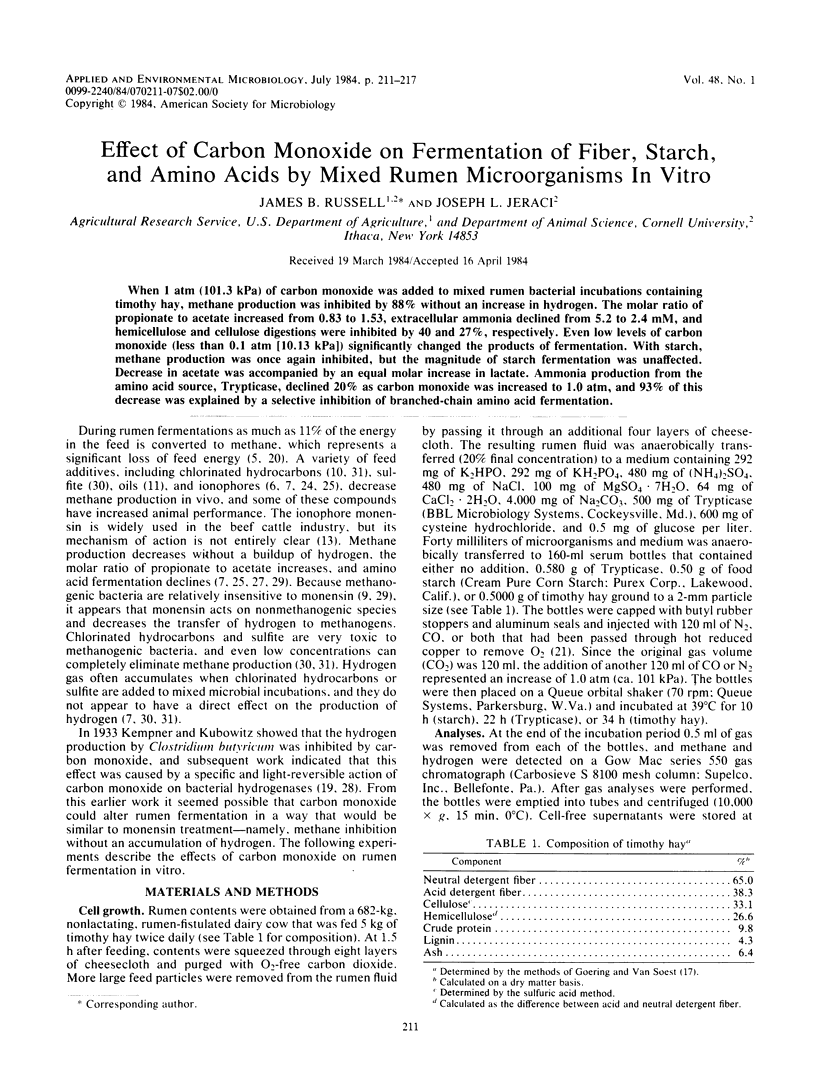
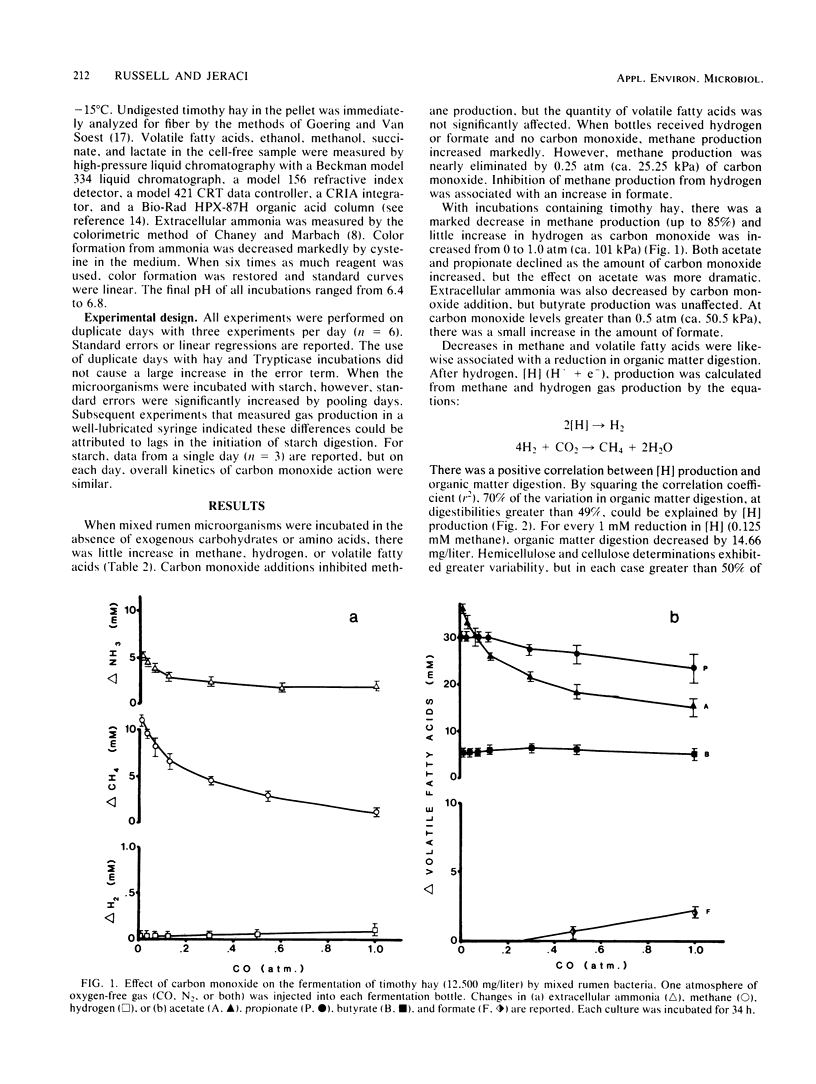
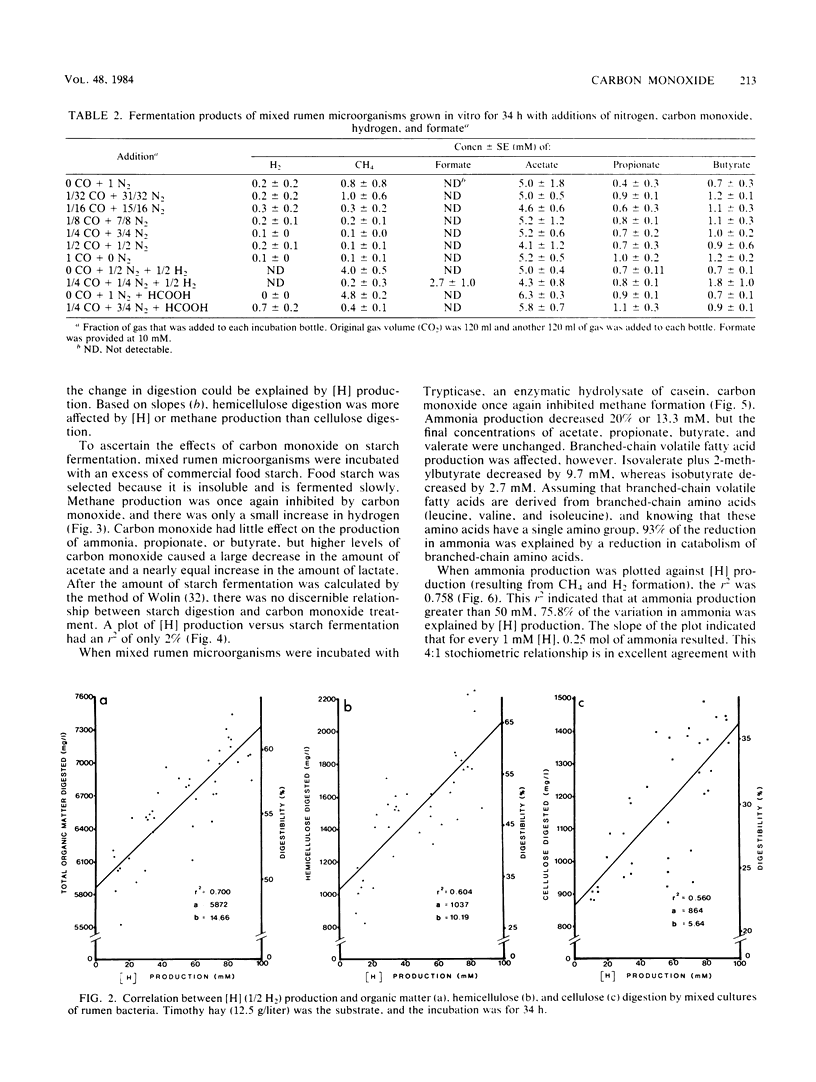
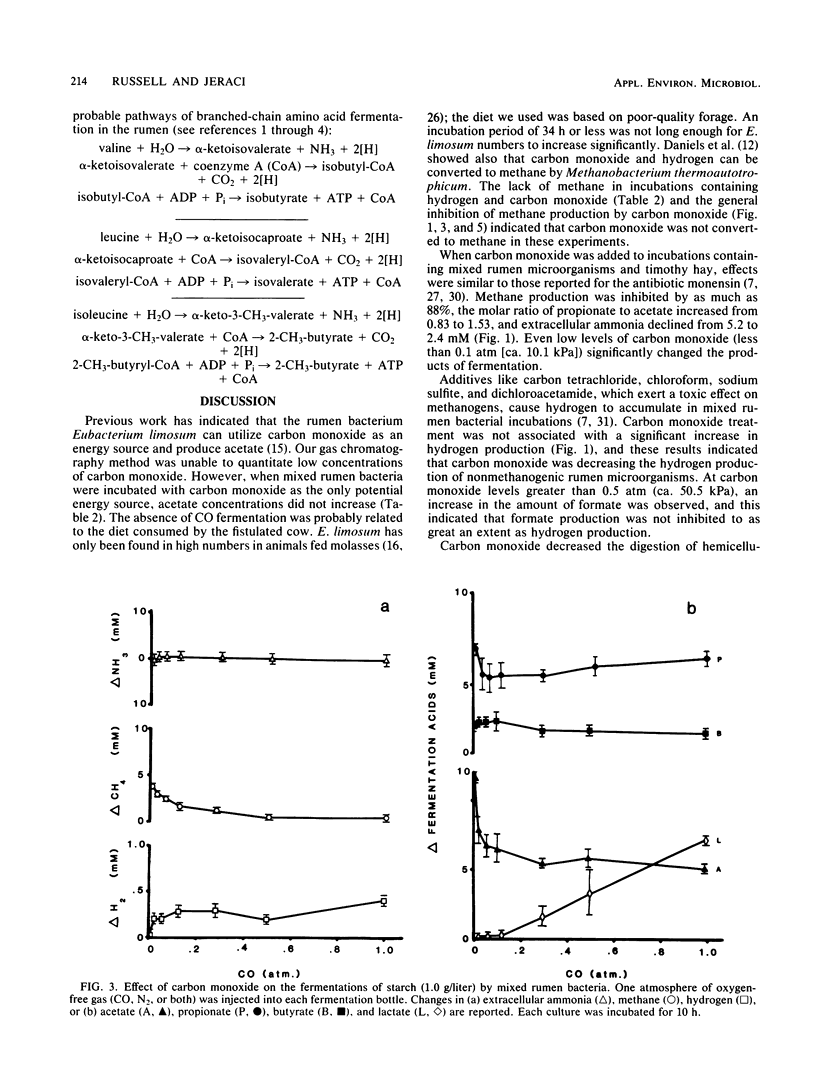
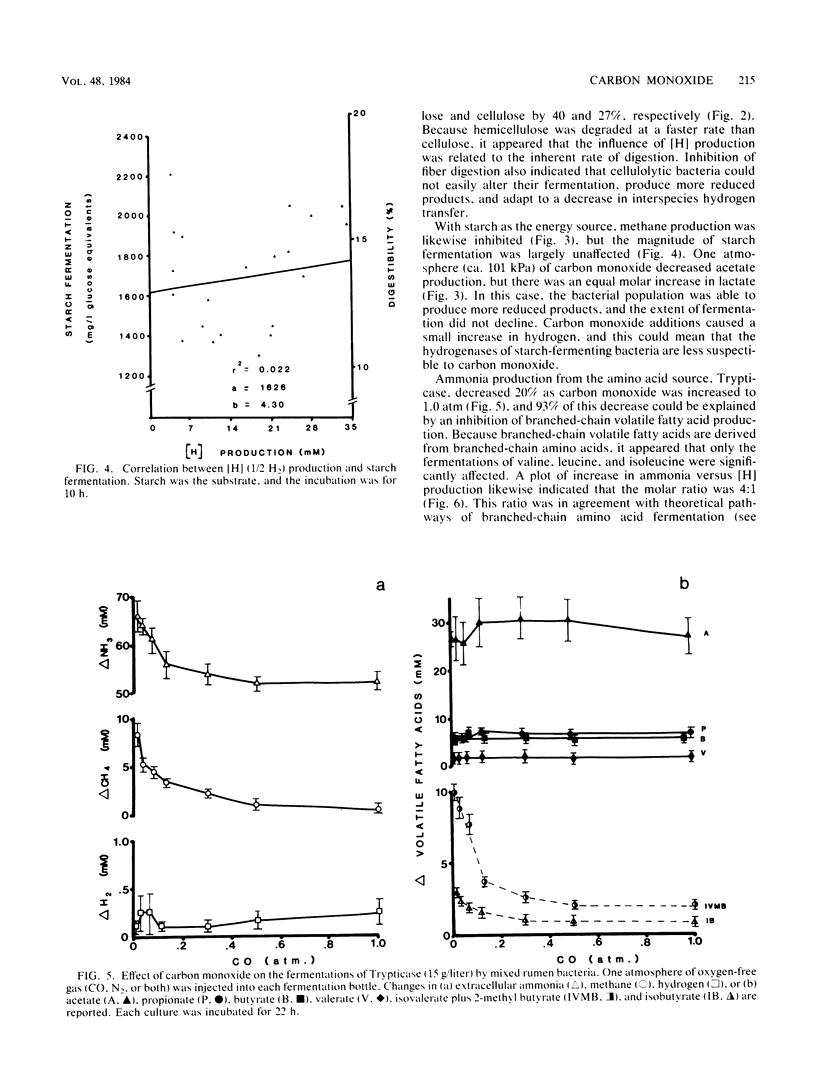
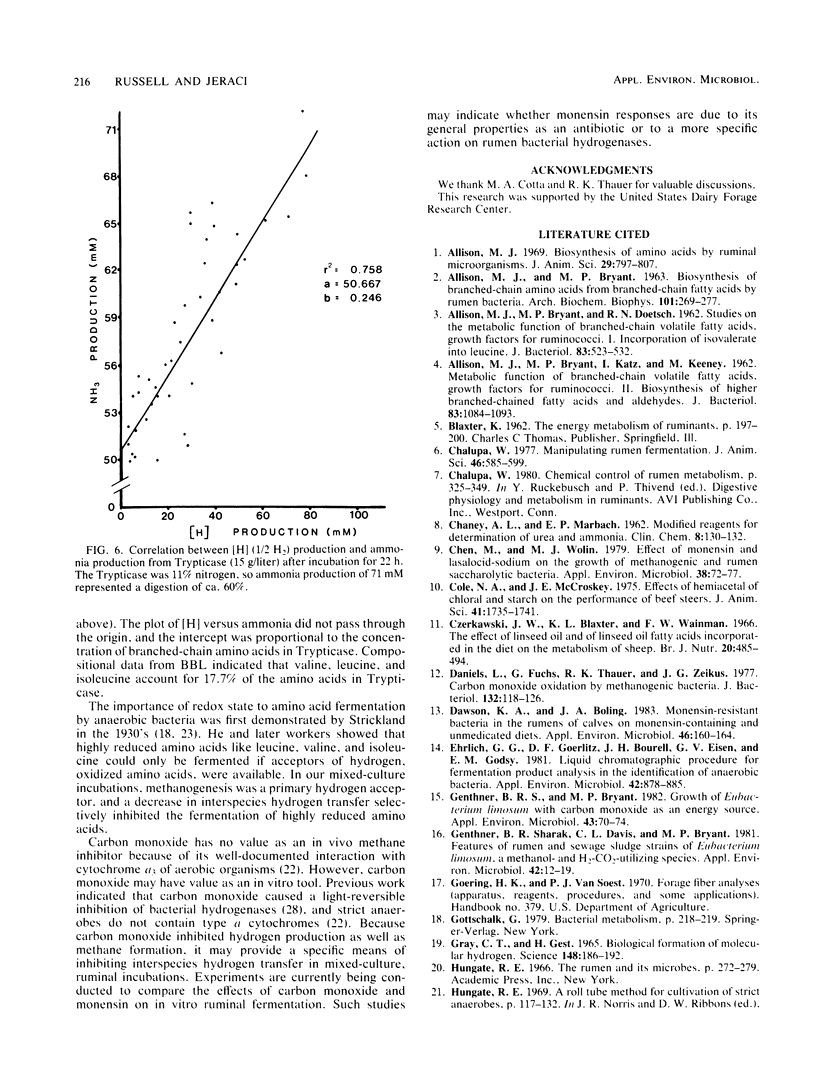
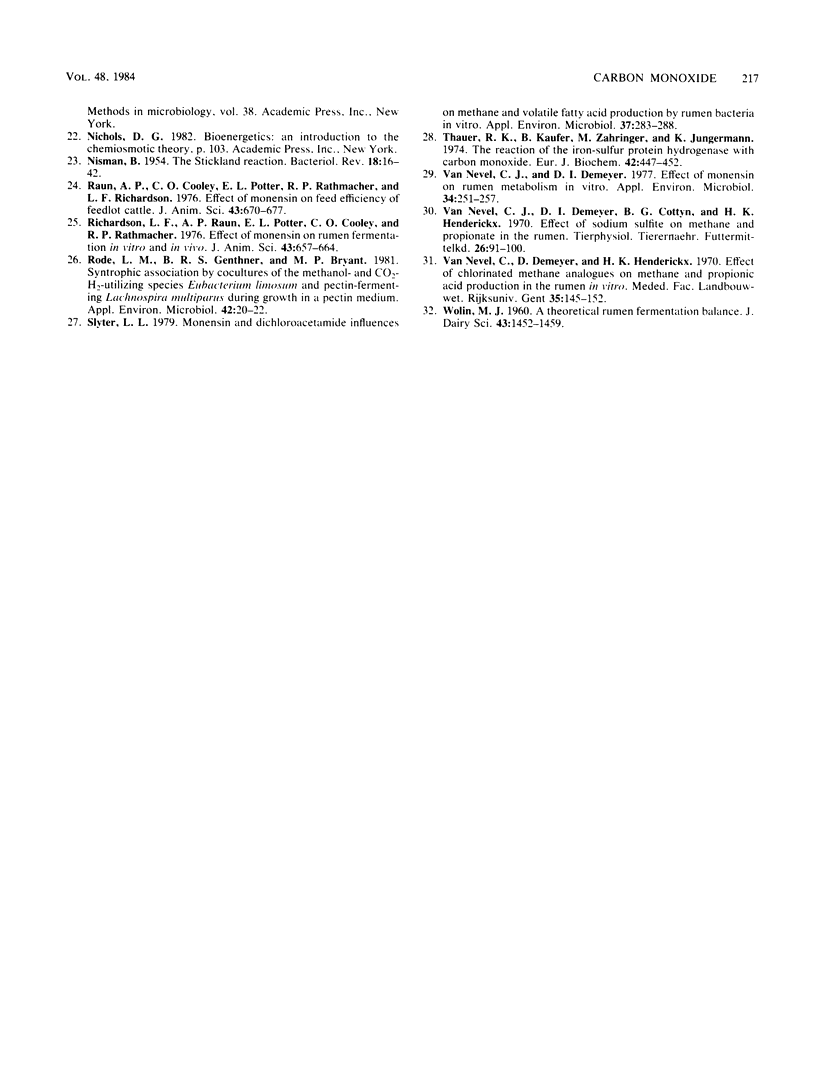
Selected References
These references are in PubMed. This may not be the complete list of references from this article.
- ALLISON M. J., BRYANT M. P. Biosynthesis of branched-chain amino acids from branched-chain fatty acids by rumen bacteria. Arch Biochem Biophys. 1963 May;101:269–277. doi: 10.1016/s0003-9861(63)80012-0. [DOI] [PubMed] [Google Scholar]
- ALLISON M. J., BRYANT M. P., DOETSCH R. N. Studies on the metabolic function of branched-chain volatile fatty acids, growth factors for ruminococci. I. Incorporation of isovalerate into leucine. J Bacteriol. 1962 Mar;83:523–532. doi: 10.1128/jb.83.3.523-532.1962. [DOI] [PMC free article] [PubMed] [Google Scholar]
- ALLISON M. J., BRYANT M. P., KATZ I., KEENEY M. Metabolic function of branched-chain volatile fatty acids, growth factors for ruminococci. II. Biosynthesis of higher branched-chain fatty acids and aldehydes. J Bacteriol. 1962 May;83:1084–1093. doi: 10.1128/jb.83.5.1084-1093.1962. [DOI] [PMC free article] [PubMed] [Google Scholar]
- Allison M. J. Biosynthesis of amono acids by ruminal microorganisms. J Anim Sci. 1969 Nov;29(5):797–807. doi: 10.2527/jas1969.295797x. [DOI] [PubMed] [Google Scholar]
- CHANEY A. L., MARBACH E. P. Modified reagents for determination of urea and ammonia. Clin Chem. 1962 Apr;8:130–132. [PubMed] [Google Scholar]
- Chen M., Wolin M. J. Effect of monensin and lasalocid-sodium on the growth of methanogenic and rumen saccharolytic bacteria. Appl Environ Microbiol. 1979 Jul;38(1):72–77. doi: 10.1128/aem.38.1.72-77.1979. [DOI] [PMC free article] [PubMed] [Google Scholar]
- Czerkawski J. W., Blaxter K. L., Wainman F. W. The effect of linseed oil and of linseed oil fatty acids incorporated in the diet on the metabolism of sheep. Br J Nutr. 1966;20(3):485–494. doi: 10.1079/bjn19660048. [DOI] [PubMed] [Google Scholar]
- Daniels L., Fuchs G., Thauer R. K., Zeikus J. G. Carbon monoxide oxidation by methanogenic bacteria. J Bacteriol. 1977 Oct;132(1):118–126. doi: 10.1128/jb.132.1.118-126.1977. [DOI] [PMC free article] [PubMed] [Google Scholar]
- Dawson K. A., Boling J. A. Monensin-resistant bacteria in the rumens of calves on monensin-containing and unmedicated diets. Appl Environ Microbiol. 1983 Jul;46(1):160–164. doi: 10.1128/aem.46.1.160-164.1983. [DOI] [PMC free article] [PubMed] [Google Scholar]
- Ehrlich G. G., Goerlitz D. F., Bourell J. H., Eisen G. V., Godsy E. M. Liquid chromatographic procedure for fermentation product analysis in the identification of anaerobic bacteria. Appl Environ Microbiol. 1981 Nov;42(5):878–885. doi: 10.1128/aem.42.5.878-885.1981. [DOI] [PMC free article] [PubMed] [Google Scholar]
- GRAY C. T., GEST H. BIOLOGICAL FORMATION OF MOLECULAR HYDROGEN. Science. 1965 Apr 9;148(3667):186–192. doi: 10.1126/science.148.3667.186. [DOI] [PubMed] [Google Scholar]
- Genthner B. R., Bryant M. P. Growth of Eubacterium limosum with Carbon Monoxide as the Energy Source. Appl Environ Microbiol. 1982 Jan;43(1):70–74. doi: 10.1128/aem.43.1.70-74.1982. [DOI] [PMC free article] [PubMed] [Google Scholar]
- Genthner B. R., Davis C. L., Bryant M. P. Features of rumen and sewage sludge strains of Eubacterium limosum, a methanol- and H2-CO2-utilizing species. Appl Environ Microbiol. 1981 Jul;42(1):12–19. doi: 10.1128/aem.42.1.12-19.1981. [DOI] [PMC free article] [PubMed] [Google Scholar]
- NISMAN B. The Stickland reaction. Bacteriol Rev. 1954 Mar;18(1):16–42. doi: 10.1128/br.18.1.16-42.1954. [DOI] [PMC free article] [PubMed] [Google Scholar]
- Rode L. M., Genthner B. R., Bryant M. P. Syntrophic Association by Cocultures of the Methanol- and CO(2)-H(2)-Utilizing Species Eubacterium limosum and Pectin-Fermenting Lachnospira multiparus During Growth in a Pectin Medium. Appl Environ Microbiol. 1981 Jul;42(1):20–22. doi: 10.1128/aem.42.1.20-22.1981. [DOI] [PMC free article] [PubMed] [Google Scholar]
- Slyter L. L. Monensin and dichloroacetamide influences on methane and volatile Fatty Acid production by rumen bacteria in vitro. Appl Environ Microbiol. 1979 Feb;37(2):283–288. doi: 10.1128/aem.37.2.283-288.1979. [DOI] [PMC free article] [PubMed] [Google Scholar]
- Thauer R. K., Käufer B., Zähringer M., Jungermann K. The reaction of the iron-sulfur protein hydrogenase with carbon monoxide. Eur J Biochem. 1974 Mar 1;42(2):447–452. doi: 10.1111/j.1432-1033.1974.tb03358.x. [DOI] [PubMed] [Google Scholar]
- Van Nevel C. J., Demeyer D. I., Cottyn B. G., Henderickx H. K. Effect of sodium sulfite on methane and propionate in the rumen. Z Tierphysiol Tierernahr Futtermittelkd. 1970 Mar;26(2):91–100. doi: 10.1111/j.1439-0396.1970.tb00128.x. [DOI] [PubMed] [Google Scholar]
- Van Nevel C. J., Demeyer D. I. Effect of monensin on rumen metabolism in vitro. Appl Environ Microbiol. 1977 Sep;34(3):251–257. doi: 10.1128/aem.34.3.251-257.1977. [DOI] [PMC free article] [PubMed] [Google Scholar]


